外研社版七年级英语名词变复数总结
七年级英语-名词单复数形式转换(大全)
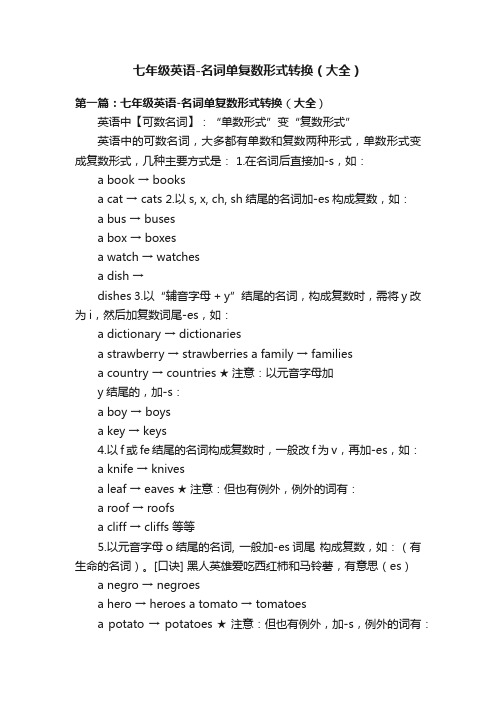
七年级英语-名词单复数形式转换(大全)第一篇:七年级英语-名词单复数形式转换(大全)英语中【可数名词】:“单数形式”变“复数形式”英语中的可数名词,大多都有单数和复数两种形式,单数形式变成复数形式,几种主要方式是: 1.在名词后直接加-s,如:a book → booksa cat → cats 2.以s, x, ch, sh结尾的名词加-es构成复数,如:a bus → busesa box → boxesa watch → watchesa dish →dishes 3.以“辅音字母+ y”结尾的名词,构成复数时,需将y改为i,然后加复数词尾-es,如:a dictionary → dictionariesa strawberry → strawberries a family → familiesa country → countries ★ 注意:以元音字母加y结尾的,加-s:a boy → boysa key → keys4.以f或fe结尾的名词构成复数时,一般改f为v,再加-es,如:a knife → knivesa leaf → eaves ★ 注意:但也有例外,例外的词有:a roof → roofsa cliff → cliffs 等等5.以元音字母o结尾的名词, 一般加-es词尾构成复数,如:(有生命的名词)。
[口诀] 黑人英雄爱吃西红柿和马铃薯,有意思(es)a negro → negroesa hero → heroes a tomato → tomatoesa potato → potatoes ★ 注意:但也有例外,加-s,例外的词有:(无生命的名词)a photo → photosa piano → pianosa radio → radios 等等6.有些名词复数有不规则变化,如:a man → mena woman → womena tooth → teetha foot → feeta child → childrena mouse → mice 7.有些名词单复数形式相同,如:a sheep → sheepa deer → deer 名词复数形式还有一些其它情况,请同学们在阅读和学习过程中不断丰富,逐步掌握。
初中知识点归纳名词的复数形式与不规则变化与句型转换
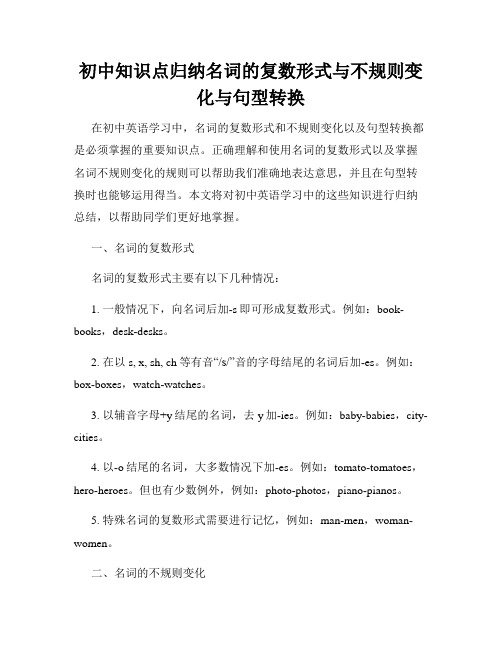
初中知识点归纳名词的复数形式与不规则变化与句型转换在初中英语学习中,名词的复数形式和不规则变化以及句型转换都是必须掌握的重要知识点。
正确理解和使用名词的复数形式以及掌握名词不规则变化的规则可以帮助我们准确地表达意思,并且在句型转换时也能够运用得当。
本文将对初中英语学习中的这些知识进行归纳总结,以帮助同学们更好地掌握。
一、名词的复数形式名词的复数形式主要有以下几种情况:1. 一般情况下,向名词后加-s即可形成复数形式。
例如:book-books,desk-desks。
2. 在以s, x, sh, ch等有音“/s/”音的字母结尾的名词后加-es。
例如:box-boxes,watch-watches。
3. 以辅音字母+y结尾的名词,去y加-ies。
例如:baby-babies,city-cities。
4. 以-o结尾的名词,大多数情况下加-es。
例如:tomato-tomatoes,hero-heroes。
但也有少数例外,例如:photo-photos,piano-pianos。
5. 特殊名词的复数形式需要进行记忆,例如:man-men,woman-women。
二、名词的不规则变化除了常见的复数形式变化外,还有一些名词是不规则变化的,我们需要熟记这些不规则的变化形式。
1. 以f或fe结尾的名词,变复数时通常去f或fe,加-ves。
例如:leaf-leaves,knife-knives。
2. 一些名词的复数形式与单数形式完全不同,需要进行牢记。
例如:child-children,foot-feet。
3. 一些名词的复数形式与单数形式相同,需要根据上下文进行判断。
例如:deer-deer,sheep-sheep。
三、句型转换在英语学习中,对于名词的复数形式和不规则变化的掌握不仅限于表达单个名词,还需要能够在句型转换中正确运用。
下面以一些常见的句型转换为例进行说明。
1. 肯定句与否定句的转换在转换肯定句和否定句时,除了动词的变化以外,名词的复数形式也需要进行相应的变化。
复数英语知识点总结

复数英语知识点总结一、英语名词复数的构成规则1. 一般情况下,名词的复数形式是在单数形式后面加上-s,例如:book → books, cat → cats。
2. 如果名词以s, ss, sh, ch, x, z结尾,则在单数形式后加-es,例如:bus → buses, class → classes, box → boxes。
3. 以辅音字母加y结尾的名词,变复数时去y变i加-es,例如:city → cities, baby → babies。
4. 以下划线结尾的名词变复数时,去掉下划线加-s,例如:brother-in-law → brothers-in-law。
5. 有些名词的单数和复数形式相同,例如:sheep → sheep, deer → deer。
6. 一些名词的复数形式是不规则的,需要特殊记忆,例如:man → men, woman → women, child → children。
二、英语名词复数的特殊情况1. 有些名词的复数形式是由拉丁语或希腊语形式直接转化而来,需要特殊记忆,例如:datum → data, phenomenon → phenomena。
2. 一些名词的复数形式是由原单数形式完全不同的词构成,例如:foot → feet, tooth → teeth, mouse → mice。
3. 一些名词的单数复数形式都一样,需要通过上下文来区分,例如:fish → fish, sheep → sheep, series → series。
4. 有些外来语保留了原单数复数格式,例如:cactus → cacti, fungus → fungi。
三、英语名词复数的使用1. 在句子中,名词的复数形式通常用来表示多个数量或者多个个体,例如:There are three books on the table.2. 名词的复数形式还可以用来表示某一类事物的普遍存在,例如:Dogs are loyal animals.3. 在某些习惯用语中,名词的复数形式可以表示某种共同的属性,例如:The rich live differently from the poor.4. 在某些情况下,名词的复数形式也可以表示某种程度或者数量,例如:He has had several accidents in his lifetime.综上所述,英语名词的复数形式是英语语法中一个重要的部分,掌握好英语名词的复数形式对于学习英语具有重要意义。
Unit 3 名词所有格课件 外研版(2024)七年级英语上册

B
A
B
C
D
Let's choose
( )7.Baby face is a friend of ____.
A. Mary mother
B. Mary's mother
C. mother of Mary D. Mary's mother‘s
Let's translate T1h.他ey们fo发un现d a了sKecirtetyt 的of一Ki个tty秘's密. 。
T2h.i这s i是s a我pa爸ir爸of的gl一as副ses眼o镜f m。y dad's. M3.arMiaaisriaa是friTeondmo的f T其om中's一. 个朋友。
self-selves wolf-wolves
小偷逃命架后藏。
thief-thieves; life-lives;shelf-shelves
五英雄般(:he以ro)o爱结吃尾西,红有柿
生(to命ma+to)e,s土,豆无生命 +(postato)和芒果(mango)
单数变复数 【规则变化】
名词的数
Let's learn more
4. 特殊所有格
the key to … the answer to … the ticket to … the way to… the exit to… the entrance to …
……的钥匙; ……的答案; ……的票(入场券); 去(通往)……的路; ……的出口; ……的入口。
30-day holiday = 30 days‘ holiday
Let's learn more
4. 特殊所有格
外研社七年级英语上册starterModule1-4知识点总结
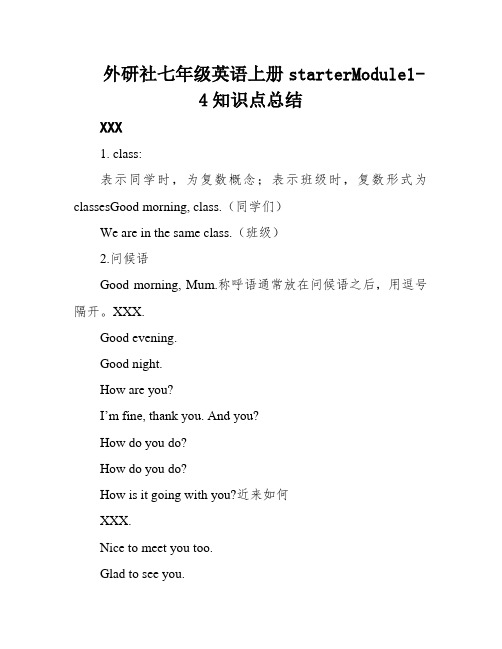
外研社七年级英语上册starterModule1-4知识点总结XXX1. class:表示同学时,为复数概念;表示班级时,复数形式为classesGood morning, class.(同学们)We are in the same class.(班级)2.问候语Good morning, Mum.称呼语通常放在问候语之后,用逗号隔开。
XXX.Good evening.Good night.How are you?I’m fine, thank you. And you?How do you do?How do you do?How is it going with you?近来如何XXX.Nice to meet you too.Glad to see you.I am XXX.XXX.See you next week.XXX.XXX.XXX—Thank you very much./Thanks a lot./Many thanks.—You’re welcome./That’s all right./That’s OK./Not at all.3.英语中中文名字的书写Zhang MinLi DamingLi Li’anXXX4.XXX先生Mrs夫人,太太,已婚女子姓氏或名字前Miss蜜斯,教师,未婚女子姓氏或名字前XXX女士,婚姻情况不详5. ---What’s your name, please?---I’m Nicole./My name is Nicole./My name’s Nicole.---Can you spell it, please?---Yes, N-I-C-O-L-E, Nocole.This is +或人“这位是...”,引见别人经经常使用的句型。
在德律风用于顶用This is...透露表现“我是...”而不消I am...1)It’s time to do sth.该做某事了,到做某事的时分了。
初中英语新外研版七年级上册Starter语法详细解析(名词+冠词)

七年级英语上册Starter语法解析一、名词解析*定义: 名词的数指数量,即“多少”。
单数:表示“一”;复数:表示“多于一”*名词可数性: 可数名词和不可数名词*可数名词单数变复数规则1.一般情况直接加s 如:star -- stars; book -- books 等2.以字母s, x, sh, ch等结尾词直接加es 如:bus --buses; watch -- watches等3.以字母f或fe结尾的词将f或fe变为v再加 es 如: leaf--leaves; knife -- knives等4.以辅音字母加y结尾的词变y为i再加es如: baby -- babies; city -- cities等5.以元音字母加y结尾的词直接加s 如:toy-- toys; monkey -- monkeys等6.以es, se, ze, ge等结尾的词直接加s 如:face -- faces; orange--oranges等7.以辅音字母加o结尾的词若表示有生命力则加es如:tomato--tomatoes; hero --heroes等若表示无生命力则加s 如:photo --photos 等8.不规则变化改a为e型: man--men; woman -- women改oo为ee型: tooth--teeth; foot --feet在词尾加-ren: child -- children单复数形式相同: sheep; deer; Chinese; Japanese常用复数形式或只有复数形式: noodles; glasses; trousers; thanks; clothes; chopsticks; people等其他特殊形式: mouse --mice老鼠; mouse -- mouses 鼠标注意: 1.有些以f或ef结尾的词直接加s变成复数:如:roof--roofs; chief--chiefs等2.由man和woman 构成的合成词,其复数形式需前后都变复数:如:man doctor -- men doctors; woman teacher -- women teachers等3.名词作定语修饰另一个名词时,通常只变后一个名词:如: boy student ---boy students; apple tree -- apple trees等*不可数名词的量化:通常不可数名词没有复数形式,不能用a/an修饰,且不能用数词直接修饰。
初中英语 外研社七年级初一上册Module1至Module5知识点

M 1 classmatesUni t 11.Chinese 中国的,中国人的,中国人,汉语其中Chinese指“中国人”时,单复数同形。
We are Chinese.She is a Chinese.国家语言某国人某国人的复数形式China Chinese Chinese ChineseJapan Japanese Japanese JapaneseEngland English Englishman EnglishmenFrance French Frenchman FrenchmenAmerica English American AmericansCanada English Canadian CanadiansRussia Russian Russian Russians Australia English Australian Australians Germany German German Germans2.MS 女士Ms 女士,用来称呼不了解婚姻状况的女性。
Miss 小姐、女士,用来称呼未婚女性。
Mrs 夫人、太太,用来称呼已婚女性。
Mr 先生,用来称呼男性,无论年龄大小结婚与否。
3.our 我们的。
形容词性物主代词。
物主代词:人称单数复数第一人称My我的Our我们的第二人称Your你的Your你们的第三人称His他的Their他们的Her她的Its它的4.Where + be + 主语 + from? “XX来自哪里?”或者“XX是哪里人?”对地点进行提问使用特殊疑问词“where”主语 + be from +地点“XX从哪里来,来自于…..”be from = come fromWe are from China=We come from China.5.How old are you ? How old + be + 主语?“XX多大?”其中,be动词要与主语一致。
6.What abour….?”……怎么样?”7.Welcome to + 地点名词“欢迎来到……”若welcome后跟here there home 等地点副词的时候,去掉to,变为“welcome here! 欢迎来到这里!”Unite 21.everyone 做主语的时候,谓语动词为第三人称单数形式。
外研社初一英语知识点M1-M2语法总结
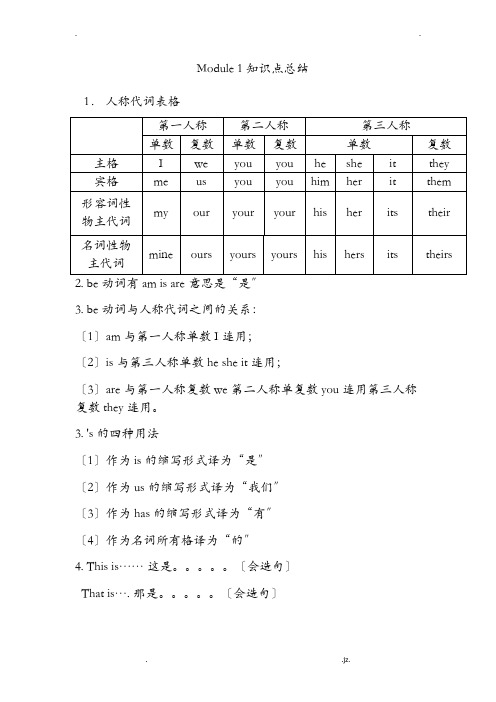
Module 1 知识点总结1.人称代词表格3. be动词与人称代词之间的关系:〔1〕am与第一人称单数I连用;〔2〕is与第三人称单数 he she it 连用;〔3〕are 与第一人称复数we 第二人称单复数you连用第三人称复数they连用。
3. 's的四种用法〔1〕作为is的缩写形式译为“是〞〔2〕作为us的缩写形式译为“我们〞〔3〕作为has 的缩写形式译为“有〞〔4〕作为名词所有格译为“的〞4. This is…… 这是。
〔会造句〕That is…. 那是。
〔会造句〕This is+人名的用法〔1〕用于介绍某人,翻译为:这是***。
〔2〕用于用语翻译为:我是***5.如何把含有be动词的肯定句变为否认句:直接在be动词后面加not6. 用yes和no来答复的疑问句叫做一般疑问句7. 如何把含有be动词的肯定句改为一般疑问句:(1)把be动词提到句首;(2)句中有第一人称要改为相对应的第二人称;(3)be动词要随着主语人称与数的变化而变化。
8.Is this ……〞引导一般疑问句的答语:〔1〕先观察主语是人还是物〔2〕如果主语是人,肯定答语为:Yes,she/he is .否认答语为:No,she/he isn’t.〔3〕如果主语是物,肯定答语为:yes, it is. 否认答语为:No, it isn’t.9. 以特殊疑问词开头的疑问句叫做特殊疑问句。
10.如何对划线局部进展提问〔1〕先把所给句改为一般疑问句〔2〕根据划线局部找相对应的特殊疑问词〔3〕把特殊疑问词放句首,后加一般疑问句。
11.重点句型〔1〕用于自我介绍:My name is +名字。
= I am +名字。
拓展:His name is +名字。
=He is + 名字。
Her name is +名字。
=He is +名字。
〔2〕用于询问对方的名字:What’s your name〞拓展:What’s his name〞What’s her name〞(4)Can you spell it〞你能拼出来吗〞(5)How are you 〞答语是I’m fine.=I’m ok.=I’m very well.=I’m not bad.=I’m very well.拓展:How is he〞/How is she〞/How is Lingling’smother〞以及根据上面的答语学会答复(6)It’s time to go now. 是该走的时候了。
初一英语名词复数形式的用法
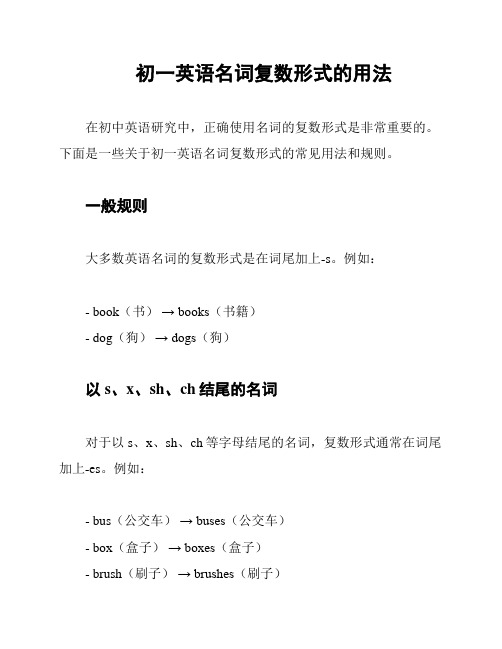
初一英语名词复数形式的用法
在初中英语研究中,正确使用名词的复数形式是非常重要的。
下面是一些关于初一英语名词复数形式的常见用法和规则。
一般规则
大多数英语名词的复数形式是在词尾加上-s。
例如:
- book(书)→ books(书籍)
- dog(狗)→ dogs(狗)
以s、x、sh、ch结尾的名词
对于以s、x、sh、ch等字母结尾的名词,复数形式通常在词尾加上-es。
例如:
- bus(公交车)→ buses(公交车)
- box(盒子)→ boxes(盒子)
- brush(刷子)→ brushes(刷子)
以辅音字母+y结尾的名词
对于以辅音字母+y结尾的名词,复数形式通常将y改为i,然后加上-es。
例如:
- baby(宝宝)→ babies(宝宝)
- city(城市)→ cities(城市)
以元音字母+y结尾的名词
对于以元音字母+y结尾的名词,复数形式通常在词尾加上-s。
例如:
- toy(玩具)→ toys(玩具)
- boy(男孩)→ boys(男孩)
不规则复数形式
一些英语名词的复数形式没有固定的规则,需要通过记忆研究。
以下是一些常见的不规则复数形式示例:
- child(孩子)→ children(孩子们)
- tooth(牙齿)→ teeth(牙齿)
- foot(脚)→ feet(脚)
请记住以上常见的名词复数形式用法和规则,以便在英语学习
中正确使用名词的复数形式。
通过反复练习,你将更加熟练地运用
这些知识。
外研版七年级英语:语法详解
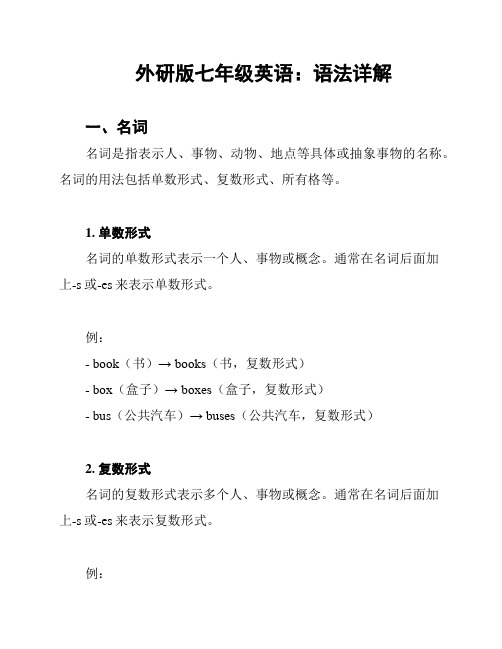
外研版七年级英语:语法详解一、名词名词是指表示人、事物、动物、地点等具体或抽象事物的名称。
名词的用法包括单数形式、复数形式、所有格等。
1. 单数形式名词的单数形式表示一个人、事物或概念。
通常在名词后面加上-s或-es来表示单数形式。
例:- book(书)→ books(书,复数形式)- box(盒子)→ boxes(盒子,复数形式)- bus(公共汽车)→ buses(公共汽车,复数形式)2. 复数形式名词的复数形式表示多个人、事物或概念。
通常在名词后面加上-s或-es来表示复数形式。
例:- books(书,复数形式)→ book(书,单数形式)- boxes(盒子,复数形式)→ box(盒子,单数形式)- buses(公共汽车,复数形式)→ bus(公共汽车,单数形式)3. 所有格名词的所有格表示所属关系或归属关系。
通常在名词后面加上-apostrophe和-s来表示所有格形式。
例:- Mary's book(玛丽的书)- the cat's tail(猫的尾巴)- the students' bags(学生们的书包)二、动词动词是表示行为、状态或存在的词语。
动词的用法包括时态、语态、情态动词等。
1. 时态动词的时态表示动作或状态发生的时间。
常见的时态有一般现在时、一般过去时、一般将来时等。
例:- I play soccer every day.(我每天踢足球。
)(一般现在时)- She watched a movie last night.(她昨晚看了一部电影。
)(一般过去时)- We will visit our grandparents next week.(我们下周会去看望我们的祖父母。
)(一般将来时)2. 语态动词的语态表示动作的主体和客体之间的关系。
常见的语态有主动语态和被动语态。
例:- The cat chased the mouse.(猫追逐老鼠。
)(主动语态)- The mouse was chased by the cat.(老鼠被猫追逐。
七年级英语可数名词变复数的知识总结
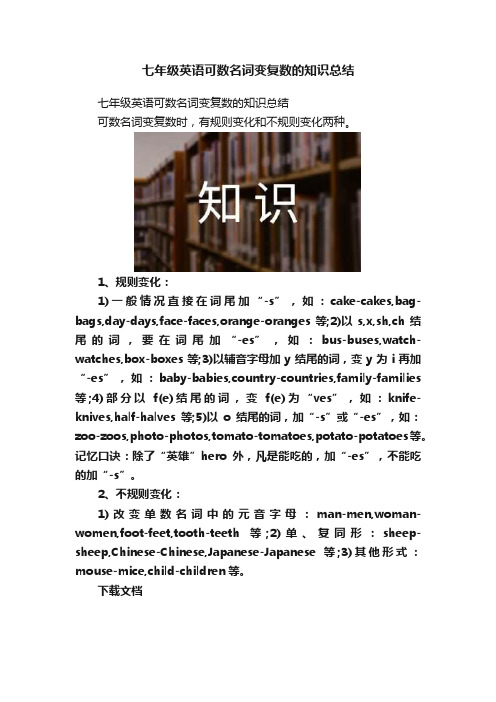
七年级英语可数名词变复数的知识总结
七年级英语可数名词变复数的知识总结
可数名词变复数时,有规则变化和不规则变化两种。
1、规则变化:
1)一般情况直接在词尾加“-s”,如:cake-cakes,bag-bags,day-days,face-faces,orange-oranges等;2)以s,x,sh,ch结尾的词,要在词尾加“-es”,如:bus-buses,watch-watches,box-boxes等;3)以辅音字母加y结尾的词,变y为i再加“-es”,如:baby-babies,country-countries,family-families 等;4)部分以f(e)结尾的词,变f(e)为“ves”,如:knife-knives,half-halves等;5)以o结尾的词,加“-s”或“-es”,如:zoo-zoos,photo-photos,tomato-tomatoes,potato-potatoes等。
记忆口诀:除了“英雄”her o外,凡是能吃的,加“-es”,不能吃的加“-s”。
2、不规则变化:
1)改变单数名词中的元音字母:man-men,woman-women,foot-feet,tooth-teeth等;2)单、复同形:sheep-sheep,Chinese-Chinese,Japanese-Japanese等;3)其他形式:mouse-mice,child-children等。
下载文档。
外研版英语七年级上册语法总结
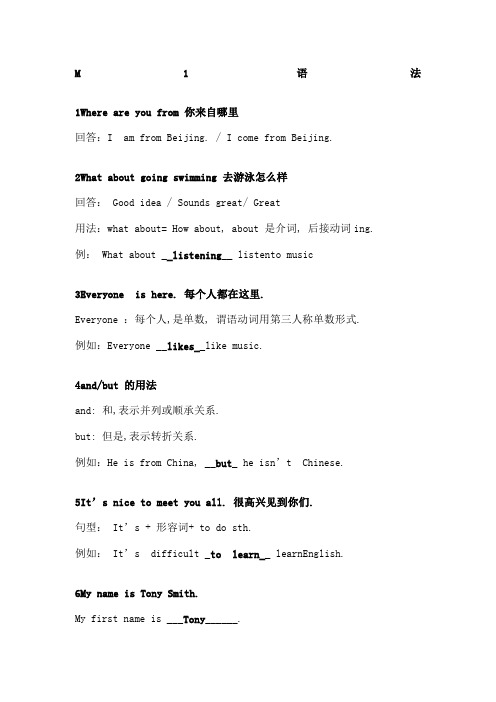
M1语法1Where are you from 你来自哪里回答:I am from Beijing. / I come from Beijing.2What about going swimming 去游泳怎么样回答: Good idea / Sounds great/ Great用法:what about= How about, about 是介词, 后接动词ing.例: What about __listening__ listento music3Everyone is here. 每个人都在这里.Everyone :每个人,是单数, 谓语动词用第三人称单数形式.例如:Everyone __likes__like music.4and/but 的用法and: 和,表示并列或顺承关系.but: 但是,表示转折关系.例如:He is from China, __but_ he isn’t Chinese.5It’s nice to meet you all. 很高兴见到你们.句型: It’s + 形容词+ to do sth.例如: It’s difficult _to learn__ learnEnglish.6My name is Tony Smith.My first name is ___Tony______.my last name is___Smith______.7Be 的用法1. Be 包括 is,am, are.2. Be 搭配口诀: I 用am, you 用are, is 用于he, she, it. 单数和不可数名词用is,复数全用are.3. Be 的肯定变否定,be + not4. Be 的缩写:I am = I’m ; you are = you’rehe is = he’s ; she is =she’s ; it is =it’s; what is =what’s 5. Be 的疑问句:Be + 主语+ 其他回答: Yes, 主语+be. / No, 主语+be not.M2语法1What/How 引导的感叹句What + a/an + 形容词+ 名词 + 主语+谓语= How + 形容词 / 副词+ 主语 +谓语What a big family it is =How big the family isWhat fine weather it is = How fine the weather is2in front of 在前面 / in the front of 在前部3名词所有格两人共有:A and B’s + is两人分别有: A’s and B’s +are例如: Mrs Green is __A__ mother.A. Lingling and Lucy’sB. Lingling’s and Lucy’sC. Lingling’s and Lucy4合成词合成词变复数,一般情况,后面的单词变复数.boy student ___boy students____bus driver __bus drivers______2. 含woman 和man的合成词变复数,两个都要变复数. man teacher ___men teachers_______woman doctor __women doctors_____5What’s your father’s job你的爸爸是做什么工作的= What does your father do= what is your father回答: He is a teacher.6Beijing is the capital of China. 北京是中国的首都. China — Chinese England – EnglishJapan – Japanese America – AmericanAfrica – African7This is a photo of my family. 这是我的一张全家照.a photo of …的一张照片8名词所有格有生命的: Lingling’s books无生命的: a door of classroom表示时间和距离的: two hours’ time我爸爸的一个朋友: a friend of my father’s9方位介词on the left 在左边; on the right 在右边in front of 在前面; next to = near 紧靠in the middle of 在中间10She and Daming’s mother are at the same hospital. 她和大明的妈妈在同一家医院工作.11My father is a bus driver, and he works in a bus station.职业的单词:policeman; doctor; nurse; teacher; actor; manager.M3语法1数字one, two, three, four, five, six, seven, eight, nine, ten.eleven, twelve, thirteen, fourteen, fifteen , sixteen,seventeen, eighteen, nineteen, twenty.thirty, forty, fifty, sixty, seventy, eighty, ninety, hundred. 2What’s your classroom in England like 你在英国的教室是什么样子的be like = look like 看起来像3 a lot of = lots of 许多a lot of / lots of 后接可数名词复数时,等于many; 后接不可数名词时, 等于much.4furniture 家具总称; food ; drink; information 信息,这些词都是不可数名词,用is5some / any 一些1. Some : 用于肯定句表示请求和建议,希望对方肯定回答的句子Would you like some milkWhat about some milkCan I have some milk2. any: 用于否定句和疑问句中例如:I haven’t got __any__ some/any apples.Would you like _some___ some/any apples6on the wall / in the wall 在墙上/在墙里例如: a door is _in the wall______________a map is __on the wall__________7with / and 的区别with 和 and 都有“和”的意思with 强调前者. 例如: Jack with his father __goes____go to park. and 强调两者都.例如: Jack and his father ___go_____go to park. 8There be 句型There be 表示“有” there is / there are含义:表示某地存在某人/某物have:强调某人/某物拥有句型:1肯定句: There is / are + 某人/某物2否定句: There isn’t / aren’t + 某人/某物3疑问句: Is / Are + there + 某人/某物Yes, there is . / No, there isn’t. Yes, there are . / No, there aren’t4. 就近原则: is 和are 的选择由最靠近它的名词的单复数决定.例如: There __is____ a pen and two books.There ___are____ two books and a pen.M4语法1food/drink 不可数名词1drink “饮料”,是不可数名词,用is2drink : have a drink3drink: “喝”, drink tea.2too much /too many 太多1too much + 不可数名词2too many + 可数名词复数3much too + 形容词 much too big3kind 种类1a kind of 一种2different kinds of 不同种类的3be kind to sb. 对某人和蔼4health / healthy 健康/健康的1I t is good for your health, please keep healthy. 2stay healthy; keep healthy; healthy food.5a bit of一点She has __a bit of _____ money. = a little6remember 记得remember to do sth. 记得去做某事remember doing sth. 记得做过某事7or 或者; 还是在肯定句中:表示”或者”在否定句和疑问句中,常用or 来代替 and: I haven’t got a pen or a book.在并列句中:表示“否则”: Hurry up, or you will be late.8have got/has got 句型1. 定义:拥有. have got = have ; has got =has2. 句型:肯定句:主语+ have got /has got +其他否定句:主语+ haven’t got /hasn’t got +其他疑问句:Have /Has+ 主语+ got + 其他回答: Yes, 主语+have/has.No, 主语+haven’t / hasn’t.3.There be 和have got 的区别There be某地存在某人/某物;强调存在;have got 某人/某物拥有...;强调拥有9特问词what 什么 where 哪里 when 何时 who谁 which 哪一个 How 方式或状态What time 什么时刻 How old 多大What colour 什么颜色How often 多少次once / twice / three times10is good for 对…有益反义词 is bad for对…有害11名词1. 可数名词--单数变复数规律:1一般情况:加s2 以s, x, ch, sh 结尾:加esbuses , boxes, watches3以“辅音+y”结尾的,变y为i, 加es. family -families, city- cities 4以f/fe 结尾:把它变成ves. leaf-leaves, wife-wives, knife-knives 5 以o结尾,记口诀: photo-photosNegroes and heroes like potatoes and tomatoes.黑人和英雄喜欢马铃薯和西红柿.6man – men; woman- women; child- children7oo-ee: foot-feet; tooth-teeth; goose-geese8 单复数同型:三人: Chinese; English; Japanese三物: fish; deer; sheep9 特殊单词mouse- mice ; ox- oxen; German - Germans2. 不可数名词1分类:液体类: water; tea; milk 等肉类: meat; fish; beef 等其他类: chocolate; bread; money; sugar; paper; work; homework; time; food; drink; furniture; information 等2用法1. 不可数名词,不用a/an,不加s /es 变复数2. 不可数名词,看作单数,和is 搭配3. 和 a little / little / a bit of 搭配4. 和 much 搭配M5 语法1时间表达法to1. 顺读法It' s + 点钟+ 分钟2. 逆读法It's + 分钟+... + 点钟1小于30分钟:It's + 分钟+ past + 点钟2等于30 分钟:It's + half past + 点钟3大于30分钟: It's + 60-分钟+to+ 点钟+14整点: It's + 点钟+ o'clock5等于15分钟:It's + a quarter past + 点钟6等于45分钟: It's + a quarter to + 点钟+1 2问时间What time is it = What' s the time /回答: It' s + 时刻3because 因为用Why 来提问, 用because 来回答有because 无so, 有though 无but4talk to / talk with 与...交谈5start to do sth 开始去做某事= begin to do sth6have 的用法have : 拥有have breakfast/ have lunch/have dinner : 吃早餐/中餐/晚餐have Chinese : 上语文课have a look : 看一看7house / home / family 的用法house : 房子强调建筑物home: 家乡带有感情色彩family : 家庭或家人8look / see/ watch / read 的用法look at : 看强调动作see: 看强调结果watch : 观赏watch TV/ watch gamesread : 阅读 read books9一般现在时1. 定义表示经常或反复发生的动作2. 用法:1 表示经常发生的动作V原或者V三单2 表示现在的状态Be3 表示客观事实或普遍真理.3. V形Be is /am /are ; V原; V三单当主语是第三人称单数4. 句型1.肯定句:主语+ be + 其他主语+ V原 + 其他;主语+ V三单+其他2.否定句:主语+be +not +其他主语+ don’t + V原+ 其他主语 + doesn’t + V原 + 其他3.疑问句: Be + 主语 + 其他Do + 主语 + V原 +其他Does + 主语 + V原 +其他注意:在主+谓+宾结构中,否定句和疑问句要借助助动词do 或does,助动词do/does 后加动词原形5. 标志词always, usually , often, sometimes, seldom很少, never从不,every day, on Mondays6. 练习题He __plays___ play basketball everyday.Daming __doesn’t like___ not like art .My friends __don’t come____ not come._Does___ the cat _eat____ eat fishWe always __watch____ watch TV.M6 语法1such as 例如2other 其他other animals = others 其他动物one … the other 一个…另一个some … the others 一些…另一些3Shall we go and see them 我们可以去看看他们吗Shall we + V原型祈使句4a little /little + 不可数名词a few / few + 可数名词复数5as well as 并且;还as well as = with 强调前者例如:He as well as his father ___has____ have lunch. 6be good at = do well in 擅长at 和in是介词,后接动词ing.例如: He is good at __swimming_____swimHe does well in __swimming____swimM7语法1connect …to …把…连接到…2turn on 打开; turn off 关闭turn up 调大声; turn down 调小声例如: It’s so dark, please _turn on_ the light.3first 第一序数词; one 一基数词He is the _first____ one to come here.4 表示顺序的词first: 首先 next : 接下来 then: 然后 finally : 最后5finally 最后__Finally____ final, you can click the mouse.6print 打印; printer 打印机Please use the __printer___print7mouse 老鼠;鼠标 miceThere are some __mice____mouse.8share … with…与…分享9plan 计划What’s your plan for your summer holidayI plan __to go___go to Beijing.10sometimes 有时例如:_____C_____ my mother goes to work by taxi.A.Some timesB. Some timeC. Sometimes 11特殊疑问句1结构:特问词+ 一般疑问句2特问词:What 什么 where 哪里 ; who 谁 ; whose 谁的 ;which哪个; when何时; how如何,方式或状态;What time什么时刻; what colour什么颜色How soon多快; in an hour; how long多长; how often 多少次;once; twice; three times; alwaysHow many问数量;可数名词how much问数量;不可数名词;问价格3做题方法:根据答语选择特问词,问什么答什么M8语法1Would you like to come to my birthday party 你愿意来参加我的生日聚会吗Would you like + sth.Would you like to do sth.回答: Yes, I’d love to. / Yes, please.No, thanks. / I’d love to, but…例如: Would you like ___to visit__ visit the Great Wall2give sth. to sb. = give sb. sth.buy sth. for sb. = buy sb. sth.3exercise 练习泛指练习时,是不可数名词:do some exercise特指具体的练习时,是可数名词复数: do eye exercises; do morning exercises.4search for information 搜索信息5use ... to do …用…做…6Do you sing it in Chinese or in English选择疑问句,问什么答什么,不能用Yes/No回答.7wear 穿戴wear: 强调穿戴的状态 wear + 衣服,帽子,眼镜,鞋子put on : 强调穿的动作 Please _put on_ your coatdress : 装扮 dress sb. He dresses himself8choose 选择choose to do sth. 选择去做9paper 不可数名词,用is10 information 不可数名词,用is11spend 花费1. spend 时间或者金钱2. 人+ spend + 时间/金钱 + on sth.人 + spend + 时间/金钱 + in doing sth.例如: It’s said that we’ll have to _D___ one hour ________ to Beijing.A. take; flyingB. takes; to flyC. spends; to flyD. spend; flyingM9语法1a few ; few / a little ; little 的用法2lie 躺着;说谎1. 躺着: lie - lying2. 说谎: tell a lie3enjoy 享受1. enjoy doing sth.例如:They are enjoying _listening_____listen to music.2. enjoy yourself = have a good time 玩得开心4It' s time to go back to school now. 到时间回学校了.句型: It's time to do sth.例如: It's time __to have____ have lunch.5moment 时刻at the moment = at this moment= now=right now用于现在进行时6leave 离开leave A : 离开Aleave for A : 前往A7get on 上车; get off 下车; get up 起床8sleep 睡觉go to sleep 入睡; go to bed 上床睡觉9现在进行时: V 变Ving1. 一般情况:加ing2. 以e结尾:去e加ing : take- taking; make-making3. 双写末尾辅音:swim-swimming; shop-shopping; run-running; sit-sitting; put-putting;begin-beginning4.特殊: lie-lying; die-dying; tie-tying10on the same day 在同一天11lying in the sun 躺在阳光下12by + 方式by bus; by email; by bikeM10语法1happen 发生1. What's happening to you 你发生了什么事= What' s up= What's the matter= What's wrong with you2. happen to do sth. 碰巧做某事例如:Mary happens __to see______ see a cat.2get ready for 为...做准备get ready for sth. = get ready to do sth.例如:We are getting ready for __learning___ learn a dragon dance. = We are getting ready _to learn____ learn a dragon dance. 3join 加入join + 人; join in + 活动4put away 收拾; sweep away 扫地1.名词可以放中间或者后面put the paper away = put away the papersweep the paper away = sweep away the paper2.代词只能放中间put it away / put them awaysweep it away / sweep them away5hurry up 快点Hurry up, or you will be late 快点,否则你就迟到了.hurry to do sth. 匆忙去做某事6look 看have a look 看一看; look at 看have a look at7mean 意味着It means + doing sth. 意味着做某事It means __learning___ learn English is very important. 8celebrate ... with... 以...方式庆祝。
七年级上册英语重点语法―可数名词单数变复数变化规则

七年级上册英语重点语法―可数名词单数变复数变化规则英语可数名词单数变复数变化规则:1.一般名词复数是在名词后面加上“s”,如map→maps,bag→bags,book-books等;2.以s,x,sh,ch结尾的词加“es”,如bus→buses,watch→watches,box-boxes等;3.以y结尾的分为两种1》以辅音字母+y结尾的词,变y为i加es,如baby→babies,family-families, study-studies等2》以元音字母+y结尾的名词变复数时,直接加s变复数,如monkey→monkeys,holiday→holidays,storey→storeys(楼层);¥4以f或fe结尾的名词变复数时,去掉f,fe加ves的名词有:half→halvesknife→knives leaf→leaves wolf→wolves wife→wives life→lives thief→t hieves5.以o结尾的名词变复数时:a)加s的名词有(无生命):photo→photos,piano→pianos,radio→radiosb)加es的名词有(有生命):即“黑人英雄爱吃土豆西红柿”+es黑人negro→negroes英雄hero→heroes土豆potato→potatoes西红柿tomato→tomatoes名词单数变复数的练习题一、写出下列名词的复数形式1、orange__________2、class ___________3、monkey__________4、piano___________5、child ___________6、shelf ____________7、bed____________8、country__________9、family___________10、toy__________ 11、foot __________ 12、radio__________13、photo__________ 14、tomato___________ 15、woman___________16、knife________17、sheep__________18、ship__________ 19、dish___________20、mouse___________二、用所给的单词的复数的正确形式填空:1> There arethree_____________(chair) in the classroom.2> These_____________(tomato) are red.3> My brother looks aftertwo_____________ (baby)4> My father likes toeat_____________ (potato).5> Chinese_____________(people)like to eat noodles.6> I have a lot of_____________ (toy) in my bedroom.7> My mother wash_____________(dish) in the kitchen.8> I have two_____________(pencil-box).9> There aresome_____________ (bus)in the street.10> Monster haseight_____________ (foot).三、选择填空( )1.I can see three ________ in the zoo.A. monkeysB. monkeysC. monkey( )2. The pig has four ________.A. footB. feetC. foots( )3. My two brothers are ________.A. policemanB.policemansC. policemen( )4. I can see ten _____ in the picture.A. sheepB. dogC. pig( )5. The _____ has three_____.A. boys, watchesB.boy, watchC.boy, watches( )6. Can you see _______on the plate?A. breadB. breadsC. breades( )7. The girl often brushes her_____ beforeshe goes to bed.A. toothB. toothsC. teeth( )8. Mr. Black often drink some_________.A. milkB. milkskes( )9. There are some _____on the floor.A. childB. manC. books( )10. Lucy will has some _______.A. photoB. photosC. photoes( )11. I am drinking two ________.A. cups of waterB. cup of waterC. cups of water s( )12. The cat eats two _______ on Monday.A. mousesB. miceC. mouse( )13. I need a pen and some _____.A. booksB. deskC. chair( )14. There are______inthe room.A. photosB. photoesC. photo( )15. There is some_____in theriver.A. fishB.fishesC. fishs( )16. There___two___in the box.A. is watchB. are watchesC. are watch( )17. We have to clean___every day.1.A.our tooth B. ourtooths C. our teeth( )18. My _____ room is next to the readingroom.A.teacherB.teacher’sC.teachers( )19.Tom and Jim are ______.A.friendsB.friendC.brother( )20.How many _____do they have?A.pictureB.picturesC.a picture四写出下列名词的复数形式。
七年级英语上册语法(可数名词复数变化规律)

七年级英语上册语法:可数名词单数变复数规律及读音
一、可数名词单数变复数规律
1. 一般在名词的词尾加-s。
如:banana --- bananas
2. 以-s , -x, -sh, -ch 结尾的名词, 在词尾加-es构成复数形式.
如:watch --- watches,box --- boxes
3. 以辅音字母加o 结尾的名词,则加-es.
tomato---tomatoes,potato---potatoes,hero---heroes, Negro ---Negroes (黑人英雄喜欢吃西红柿和马铃薯)
以元音字母加o 结尾的名词,则直接加-s。
如radios, zoos特例:photos(缩略词),pianos(外来词)
4. 以辅音字母加-y 结尾的名词,则把-y改为i,加-es.
如:family --- families
以元音字母加y结尾的名词,直接在y后加s。
如:boys,days
5. 以-f 或-fe 结尾的名词,则把-f, -fe改为v,再加-es.
如chief --chieves(小偷),wife--wives(妻子),
knife --- knives(小刀), leaf--leaves(叶子),
wolf--wolves(狼), life --- lives(生命)
6. 有些名词以不规则来构成复数形式.
如:man --- men(男人), woman --- women (女人)child—children(孩子)
7. 有些名词单复数相同.如:sheep --- sheep (羊)deer—deer(鹿)Chinese (中国人)
二、复数名词词尾的读音。
初中英语语法知识点总结名词的复数形式大全

初中英语语法知识点总结名词的复数形式大全初中英语语法知识点总结:名词的复数形式大全_新概念_新东方在线普通的名词复数形式——加上-s对于大多数名词来说,只需要在词尾加上-s。
单数名词+s=复数名词puter -> puters(电脑)bag -> bags(包)book -> books(书)table -> tables(桌)house -> houses(房子)car -> carsstudent -> students(学生)place -> places(地点)不规则名词的复数形式-以辅音+y结尾的名词以辅音+y结尾的名词,去掉y,词尾加上ies。
以y结尾的单数名词+ies=复数名词baby -> babies(宝贝)party -> parties(聚会)paddy -> paddies(稻田)hobby -> hobbies(习惯)lady -> ladies(女士)ferry -> ferriessherry -> sherries(雪莉酒)dandy -> dandies(花花公子)不规则名词的复数形式——以SH, Ch, S, X,或Z[/cn]以SH, Ch, S, X,或Z结尾的名词,在词尾加上es。
以SH, Ch, S, X,或Z结尾的名词+es=复数名词beach -> beaches(沙滩)box -> boxes(箱子)church -> churches(教堂)buzz -> buzzes(嗡嗡声)loss -> losses(损失)fox -> foxeswatch -> watches(手表)dress -> dresses(裙子)不规则名词的复数形式——以o结尾的名词许多以辅音+o结尾的名词,o后面会在s前再加上一个e。
初中外研英语语法知识点总结
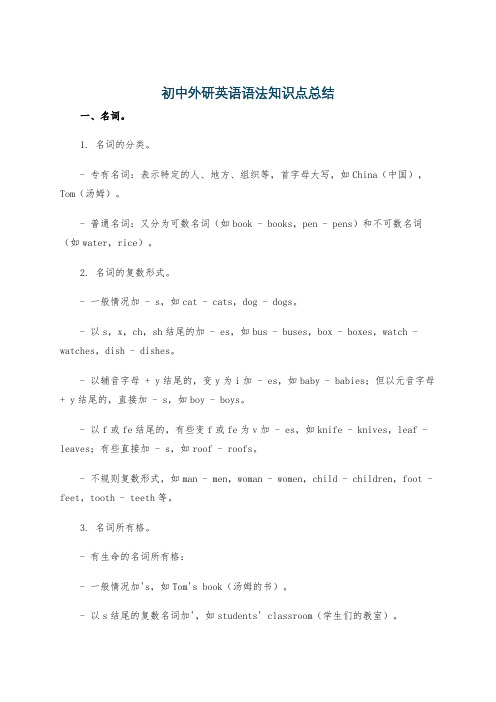
初中外研英语语法知识点总结一、名词。
1. 名词的分类。
- 专有名词:表示特定的人、地方、组织等,首字母大写,如China(中国),Tom(汤姆)。
- 普通名词:又分为可数名词(如book - books,pen - pens)和不可数名词(如water,rice)。
2. 名词的复数形式。
- 一般情况加 - s,如cat - cats,dog - dogs。
- 以s,x,ch,sh结尾的加 - es,如bus - buses,box - boxes,watch - watches,dish - dishes。
- 以辅音字母 + y结尾的,变y为i加 - es,如baby - babies;但以元音字母+ y结尾的,直接加 - s,如boy - boys。
- 以f或fe结尾的,有些变f或fe为v加 - es,如knife - knives,leaf - leaves;有些直接加 - s,如roof - roofs。
- 不规则复数形式,如man - men,woman - women,child - children,foot - feet,tooth - teeth等。
3. 名词所有格。
- 有生命的名词所有格:- 一般情况加's,如Tom's book(汤姆的书)。
- 以s结尾的复数名词加',如students' classroom(学生们的教室)。
- 表示两者或多者共有时,最后一个名词加's,如Tom and Jerry's room(汤姆和杰瑞的房间);表示各自所有时,每个名词都加's,如Tom's and Jerry's toys (汤姆的和杰瑞的玩具)。
- 无生命的名词所有格用“of + 名词”结构,如the window of the room(房间的窗户)。
二、冠词。
1. 不定冠词a/an。
- a用于以辅音音素开头的单词前,如a book;an用于以元音音素开头的单词前,如an apple。
初一名词变复数变化规则
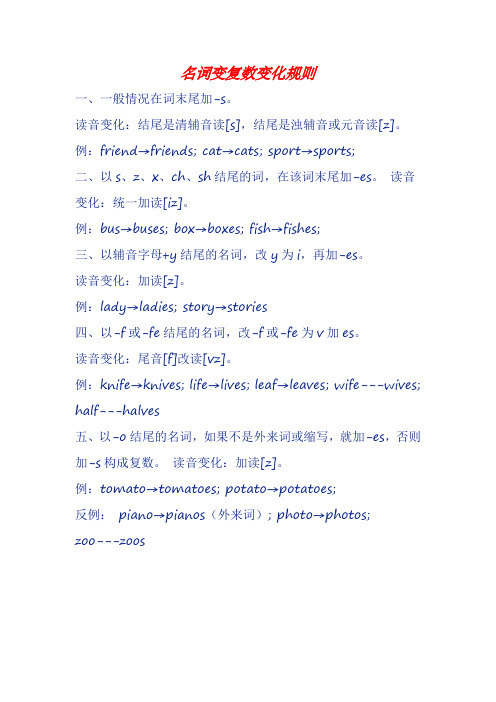
名词变复数变化规则一、一般情况在词末尾加-s。
读音变化:结尾是清辅音读[s],结尾是浊辅音或元音读[z]。
例:friend→friends; cat→cats; sport→sports;二、以s、z、x、ch、sh结尾的词,在该词末尾加-es。
读音变化:统一加读[iz]。
例:bus→buses; box→boxes; fish→fishes;三、以辅音字母+y结尾的名词,改y为i,再加-es。
读音变化:加读[z]。
例:lady→ladies; story→stories四、以-f或-fe结尾的名词,改-f或-fe为v加es。
读音变化:尾音[f]改读[vz]。
例:knife→knives; life→lives; leaf→leaves; wife---wives;half---halves五、以-o结尾的名词,如果不是外来词或缩写,就加-es,否则加-s构成复数。
读音变化:加读[z]。
例:tomato→tomatoes; potato→potatoes;反例:piano→pianos(外来词); photo→photos; zoo---zoos练习:1、orange2、class3、text4、monkey5、piano6、shelf7.dog 8、bed9、country 10、family 11、toy 12.radio13、photo 14、army 15、tomato 16、fox17、knife 18 map 19 apple 20.egg 21.fish 22.eraser 23.pen 24.pencil 25.box 26.bus27.watch 28.class 29.teacher 30.grade 31.toy 32.desk 33.ruler 34.book 35.car 36.cake 37.bag 38.school 39.telephone 40.friend 41.year 42.he 43.she 44.it 45.I 46.you 47.this 48.that 49.that 50.is。
新版外研社英语七年级(上)Starter部分知识点总结
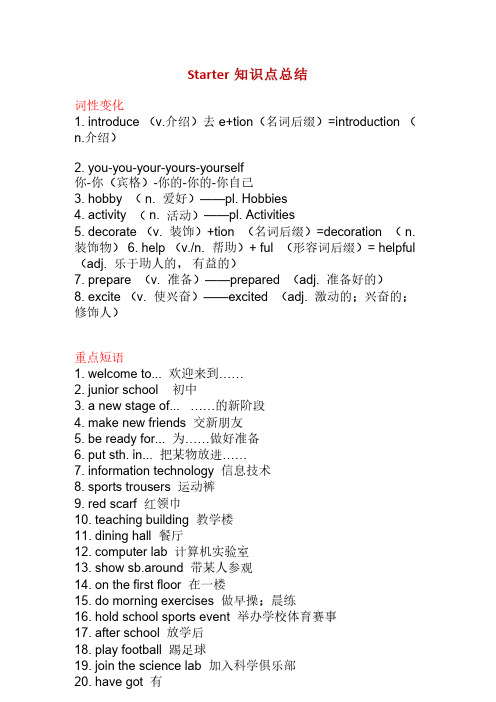
Starter词性变化1.introduce(v.介绍)去e+tion(名词后缀)=introduction(n.介绍)2.you-you-your-yours-yourself你-你(宾格)-你的-你的-你自己3.hobby(n.爱好)——pl.Hobbies4.activity(n.活动)——pl.Activities5.decorate(v.装饰)+tion(名词后缀)=decoration(n.装饰物)6.help(v./n.帮助)+ful(形容词后缀)=helpful (adj.乐于助人的,有益的)7.prepare(v.准备)——prepared(adj.准备好的)8.excite(v.使兴奋)——excited(adj.激动的;兴奋的;修饰人)重点短语1.welcome to...欢迎来到……2.junior school初中3.a new stage of...……的新阶段4.make new friends交新朋友5.be ready for...为……做好准备6.put sth.in...把某物放进……rmation technology信息技术8.sports trousers运动裤9.red scarf红领巾10.teaching building教学楼11.dining hall餐厅puter lab计算机实验室13.show sb.around带某人参观14.on the first floor在一楼15.do morning exercises做早操;晨练16.hold school sports event举办学校体育赛事17.after school放学后18.play football踢足球19.join the science lab加入科学俱乐部20.have got有21.like running喜欢跑步22.summer holiday暑假23.in the sea在海里24.help sb.with sth.在某方面帮助某人25.a bit有点,轻微26.make friends with sb.和某人交朋友27.sing songs唱歌28.think of...想;想到29.play the piano弹钢琴30.learn to do sth.学习做某事31.want to do sth.想要做某事考点精析1.let’s+V.,让我们…,表示提出建议2.the/形容词性物主代词+序数词+n.3.a lot的用法:(1)a lot+v./adj./adv./比较级,很多,非常(2)a lot of=lots of许多,大量,既可以接可数名词,也可以接不可数名词4.a bit vs a little(1)修饰不可数名词时,表示一点儿;少量a bit of=a little(2)修饰adj./adv./比较级,有点儿a bit of=a little【注意】not a bit=not at all一点也不not a little=very much非常5.play+运动play+the+乐器6.need to do sth.需要做某事(need此处为实义动词)need do sth.需要做某事(need此处为情态动词)7.some后面既可以跟可数名词复数,也可以修饰不可数名词8.more是much/many的比较级,后面既可以跟可数名词复数,也可以修饰不可数名词9.better:adj.更好的,good的比较级adv.更好地,well的比较级be better at...更擅长……10.“也”(1)too:肯定句句末,有“,”隔开。
